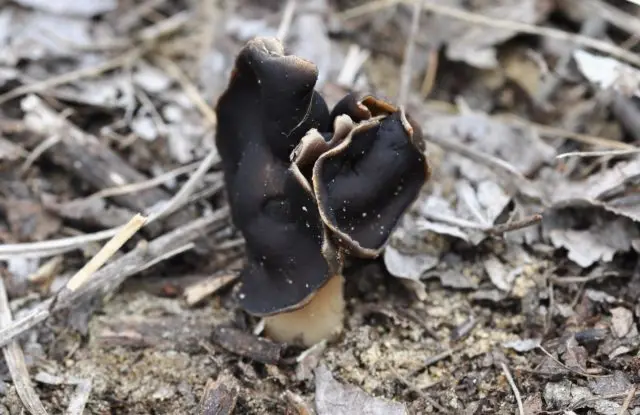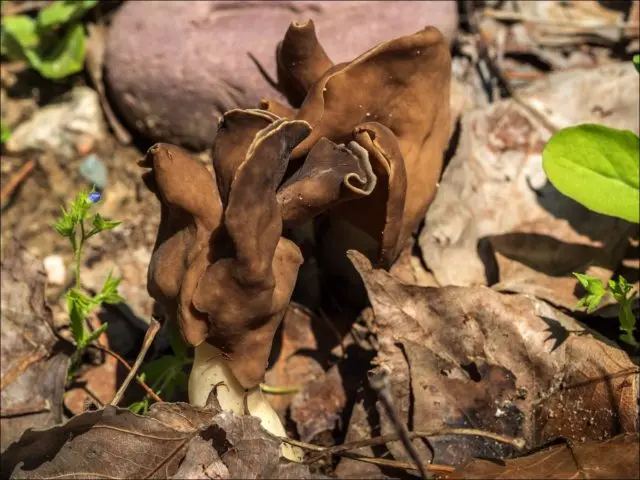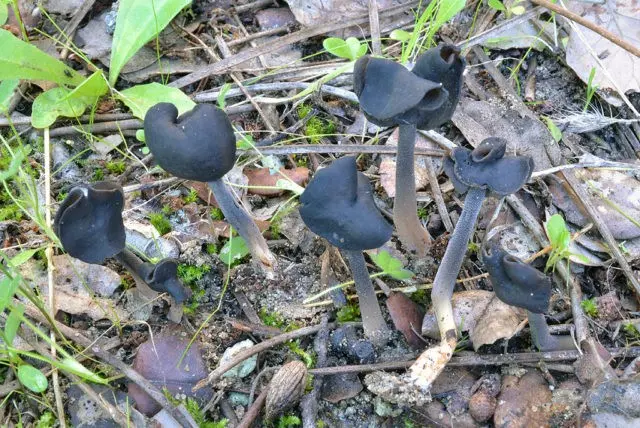Contents
The white-legged lobe has a second name – white-legged gelvella. In Latin it is called Helvella spadicea. Included in the small genus Helwell, the Helwell family. The name “white-legged” is explained by an important feature of the mushroom: its leg is always painted white. It does not change with age.

What do white-legged lobes look like
The mushroom is a typical representative of the lobe with a bizarre cap. It gives fruiting bodies a resemblance to cocked hats, saddles, hearts, mouse faces and other objects and figures. Sometimes the hats are randomly twisted. They are small in size, but quite tall. Their diameter and height are from 3 to 7 cm.
Hats have 2-3 or more saddle-shaped petals of various shapes. The maximum number is 5. They resemble blades, hence the name of the genus. The lower edges of the petals are almost always even in young mushrooms, attached to the stem. The upper surface of the cap is smooth, colored in shades of brown, closer to dark brown or even black. Some specimens have spots of lighter shades. The lower surface is slightly fleecy, its color is white or light brown, beige.

The pulp is brittle, thin, grayish. It does not have a pronounced mushroom aroma and taste.
The length of the leg is from 4 to 12 cm, the thickness is from 0,5 to 2 cm. It is even, of a classical cylindrical shape, sometimes wider at the base, often flattened. The leg is not corrugated or ribbed. In cross section, it is hollow or with small holes near the base. The color is white, some specimens may have a slight brownish tint. In old mushrooms, the stem is dirty, which is why it seems yellowed. The pulp in it is quite dense.
Helwella white-legged belongs to the section of marsupial mushrooms. Her spores are in the “bag”, in the hearth itself. Their surface is smooth. The color of the spore powder is white.
Where do white-legged lobes grow
This species belongs to the rare representatives of the Helwell family. Its distribution area is limited to the territory of Europe. In Our Country, it can be found from the western borders to the Urals.
Mushrooms can grow singly or in small groups. The most favorable conditions for them are sandy soils. Mushroom pickers most often find white-legged lobe in coniferous or mixed forests, on soil or in grass.
The fruiting period begins in late spring, from May. Lasts until the end of September – mid-October.
Is it possible to eat white-legged lobes
Among the representatives of the genus Helvella there are no edible species. The white-legged lobe is no exception. There are different opinions about the possibility of its use as a food product. Some experts classify it as a group of conditionally edible mushrooms, others – as inedible.
False doubles
The white-legged lobe has an outward resemblance to other members of its genus. The main difference by which it can be recognized is the color of the legs. It always remains white.
One of the similar varieties is Helvella pitted, or Helvella sulcata. To identify this species, you should pay attention to the stem of the fungus. It has a pronounced ribbed surface.

Another twin of Helvella spadicea is the Black Lobe, or Helvella atra. Its distinguishing feature, which helps to distinguish species, is the color of the stem. In Helvella atra it is dark gray or black.

Collection rules
It is not recommended to collect the white-legged lobe or any similar species to them. Moreover, they lack nutritional value. You can not collect and use them in large quantities, even heat treatment in this case may not save you from poisoning. Therefore, experienced mushroom pickers advise to play it safe and not put gelwells in the basket.
Use
In our country, no cases of poisoning by them have been recorded. However, there is evidence that in Europe there are victims of the consumption of the white-legged lobe.
If you still have a desire to cook these mushrooms, then you need to remember that you can’t eat them raw. This causes poisoning. The blades become edible only after a long heat treatment. Boil them for at least 20-30 minutes. In the traditional cuisines of some peoples, helwella, which has undergone the necessary processing, can be added to dishes.
Conclusion
Although the white-legged lobe is considered conditionally edible in some sources, it is not recommended to risk your health and eat it. Moreover, in terms of taste, it belongs only to the fourth category. Gelvella can cause poisoning, the degree of which depends on the amount of mushrooms eaten.









